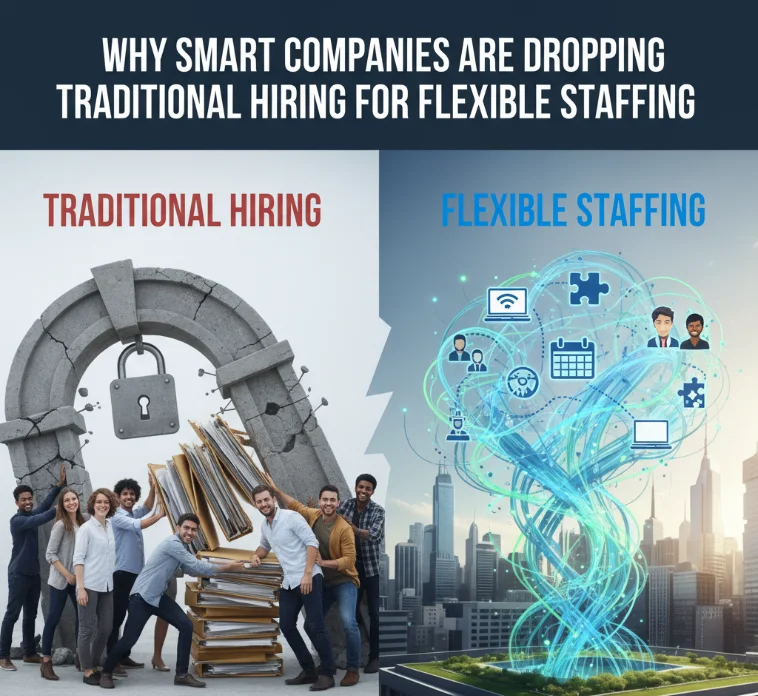Truth be told, the conventional manner of hiring appears to be ineffective at present. It’s a tale we are all familiar with—meticulously designed organizational charts, time-consuming recruiting procedures, and a permanent headcount that was visually impressive but gave you a sense of inflexibility in reality. Although a few companies are still operating within those parameters, what about the ones that are growing rapidly? They’ve moved on to something better.
Here’s what they’ve figured out: scaling your business doesn’t mean you need to hire a ton of full-time employees. What you actually need is a team that can roll with the punches when the market throws you a curveball.
And the numbers back this up. Gartner found that almost one in three organizations now use flexible workers to keep costs down. The flexible office market? It hit $47 billion this year, and experts think it’ll balloon to nearly $200 billion by 2034. That’s not a trend—that’s a movement.
The truth is, flexible workforce models give you a real competitive edge. You can grow fast without losing the agility that got you there in the first place. The smartest companies are mixing things up, combining the reliability of permanent staff with the flexibility of contract workers.
Five Game-Changing Benefits of Flexible Staffing
1. Your Budget Will Actually Make Sense
Look, we all know hiring full-time employees is expensive. But have you really thought about how expensive?
It’s not just the salary. There’s health insurance, retirement matching, PTO, training costs, office space—the list goes on. These “hidden” costs can jack up your total compensation by 30-40% above base pay. That $80,000 developer? They’re actually costing you over $100,000.
With flexible staffing, you sidestep most of that. You get experienced pros who hit the ground running, and you only pay for what you need. Here’s what that looks like in practice:
- You bring people in based on actual project needs, not guesswork about future workloads
- When the market gets shaky or things slow down seasonally, you’re not stuck with a bloated payroll
- You can pump those savings into product development, marketing, or whatever actually drives revenue
- Your core team stays lean while you tap into specialized skills exactly when you need them
This becomes a lifesaver when you’re growing aggressively. Instead of hiring 20 people and crossing your fingers that the revenue shows up, you scale your team as the money actually comes in.
2. How to Get Expert Skills Without Having to Commit for a Long Time

Maybe here’s a situation that you can recognize: you require someone to be a complete machine learning wizard for a short-term project of three months. Would you really want to employ them full-time and then have to figure out what to do with them?
Skilled employees are the main requirement of contemporary businesses. Still, such skills don’t have to result in the setting up of a permanent position. Perhaps it is a cybersecurity expert to thoroughly check your systems, a growth marketer who has quickly run successful campaigns in your industry, or a data scientist who can develop a custom analytics pipeline for you.
Having flexible staff means that you can hire these professionals without the awkward ‘what do we do now?’ discussion happening afterwards. And here’s the thing: many of these experts actually prefer working this way. They get variety, they work on interesting challenges, and they control their own schedule.
This is huge in tech. Places like Colombia have built up entire ecosystems of talented software engineers and IT professionals who work flexibly. You can tap into that talent pool immediately.
The advantages are pretty clear:
- No half-year recruitment process—it is possible to have qualified people quickly
- New ideas from people who have worked in different companies and industries
- Perfect skill matching for each specific project
- Lower risk when you’re testing something new or entering an unfamiliar market
3. Scale Up (or Down) Without the Drama
A fast-growing company can be compared to a roller coaster—with it, you are sure to have ups, downs, and sudden turns. The resources you will need will depend on the customers, competitors, and opportunities.
It’s very likely that if you quickly scale your team, you will have the opportunity to be the one who takes the advantage, while others may say that a competitor is the one who has taken it.
It usually takes a very long time to hire staff traditionally. Flexible staffing? You can bring in qualified people in days or weeks. It’s a total game-changer in these situations:
- Holiday rushes when you need all hands on deck temporarily
- Big product launches that need a surge of development and marketing muscle
- New market testing where you need local expertise but aren’t ready to commit long-term
- Crisis mode when you desperately need more capacity to keep the wheels on
But here’s what people miss: it’s not just about adding people. Flexible staffing lets you experiment. Want to test a new business line? Try it with flexible team members first. If it works, great. If not, you haven’t locked yourself into permanent overhead.
4. Let Your Core Team Do What They Do Best
When you can pull in specialized skills through flexible arrangements, something magical happens: your permanent staff can focus on what really matters.
Really think about it. If it took your product manager three months to learn advanced SQL just to be able to pull reports, you would just hire a data analyst for a couple of weeks to do that job. Your PM would keep being focused on product strategy—which is actually where they should be.
It is a kind of work that makes all people more productive. Your internal team can carry on with the strategic work that needs their profound knowledge of the company, whilst the flexible members of the team can bring targeted expertise for solving specific challenges. Most of the time, they also bring some innovative ideas that help your core team to understand the problems from a different perspective.
It creates a natural division of labor. Permanent employees maintain your culture and institutional knowledge. Flexible professionals contribute their specialized skills. Everyone wins.
5. Ship Faster and Innovate More
Speed matters a lot.
The right combination of skills in a development team that you can rapidly scale might be the difference between becoming a market leader and having to follow the competitors’ trail.
Flexible staffing allows you to put together the perfect teams for particular projects without having to go through long interviews and negotiation processes. In some cases, you are essentially reducing your time-to-market by several months. That’s huge.
On top of that, diversity of thought is what really drives innovation. If you collaborate with professionals who have different experiences within companies and industries, you receive exposure to the solutions that your permanent team may never even think of. That cross-pollination of ideas? That’s where breakthroughs happen.
How to Actually Make This Work
Okay, so flexible staffing sounds great. But you can’t just fire everyone and hire a bunch of contractors. That’s not a strategy—that’s chaos.
You need a real plan. The best approach combines different methods based on what your business actually needs. Maybe that’s:
- A core permanent team handling your essential functions
- Contractors for specialized projects with clear start and end dates
- Temporary staff to handle volume spikes
Technology is your friend here. Nowadays, employee administration systems provide you with the opportunity to handle dispersed teams, document their performance, and inform everyone, whether they are staff or not, at the same time.
Nevertheless, do not forget the basics simultaneously:
Firm onboarding processes are the means through which flexibly working team members will be able to make their contributions in a short period of time. If the team composition changes very often, good documentation becomes even more essential—make sure that you have enough resources allocated for knowledge management systems. Communication protocols that are established considering different schedules and time zones ensure that all team members have the same understanding.
Flexible workers can be allowed to be in touch with your goals through means such as regularly scheduled check-ins, milestones that are clear to everyone, and honest feedback, even though they are not physically present in the office.
What Is Coming Next
The transition to flexible work is not going to reduce its pace—it is, in fact, getting faster.
Imagine this: 44% of employees would accept a salary reduction if only they were given more liberty in arranging their work. What a great situation employers demanding agility and workers seeking autonomy create—the result is a sustainable model that is beneficial for all parties.
In addition, technology is improving further and further. Are you using collaboration tools, project management platforms, and communication apps? They are very helpful if you want to coordinate your distributed teams without any inconveniences.
By flexible staffing, companies that succeed today will be the winners tomorrow. They will be equipped with the know-how for managing hybrid teams and will have a good standing, which will appeal to top flexible talents.
The competitive environment is undergoing changes already. Those companies that fail to adjust to flexible models will be in a position where they have difficulties competing for both projects and talent.
The Bottom Line
The issue in question is not only to do with cost-cutting or reacting to economic pressures. Workforce flexibility is singled out by companies that are growing fast as a key factor that provides them with an edge in turbulent markets of today.
All five benefits work together. Cost savings let you access specialized talent. Scalability helps you focus on core functions. Innovation drives market advantage. Traditional staffing methods are insufficient to match that power.
Firms that execute flexible staffing perfectly can access talent all over the world and still be agile enough to respond quickly when markets change. It is no longer a choice in today’s business environment but rather a necessity.
The ones that will survive are the organizations that can combine the stability of permanent teams with the flexibility of staffing. This hybrid model provides you with the freedom to follow the expansion routes you have while still keeping the necessary discipline for your success to be sustainable.
Hence, the question of whether to use flexible staffing has been replaced by the question of how quickly you can put it in place effectively.
Frequently Asked Questions

















Your blog is a testament to your dedication to your craft. Your commitment to excellence is evident in every aspect of your writing. Thank you for being such a positive influence in the online community.
Usually I do not read article on blogs however I would like to say that this writeup very compelled me to take a look at and do it Your writing style has been amazed me Thank you very nice article